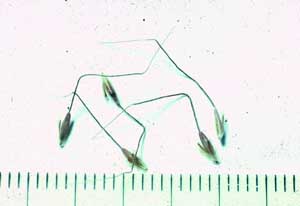|
|
 43 self-burying fruit DHJanzen100976.jpg high resolution
|
|
| While most grass seeds (Poaceae) are dispersed by some combination of rodents caching them, wind, gravity and surface rain runoff, and a few are dispersed by sticking to the outside of a mammal, one species has invented a self-burial morphology/behavior. This grass disperses itself downward into the soil (presumably to get away from seed predators such as ants and mice, and perhaps survive fires and even desiccation of the new seedling). The long projection (called an awn) from the tip of the fruit is bent at right angles. As the fruit dries in the sun, the L-shaped awn twists, literally screwing the seed down into the cracks in the soil, with the outer part of the L serving as a brace against the soil surface. | ||
back to lecture slides
or skip to: